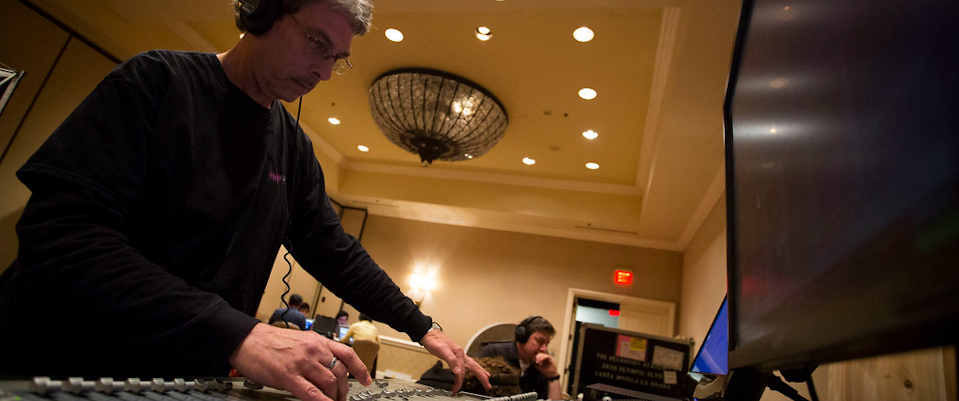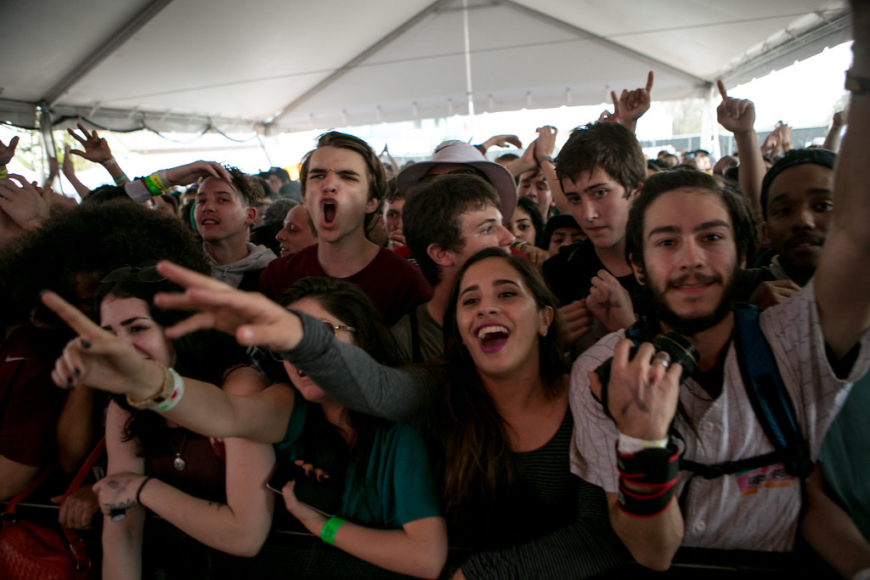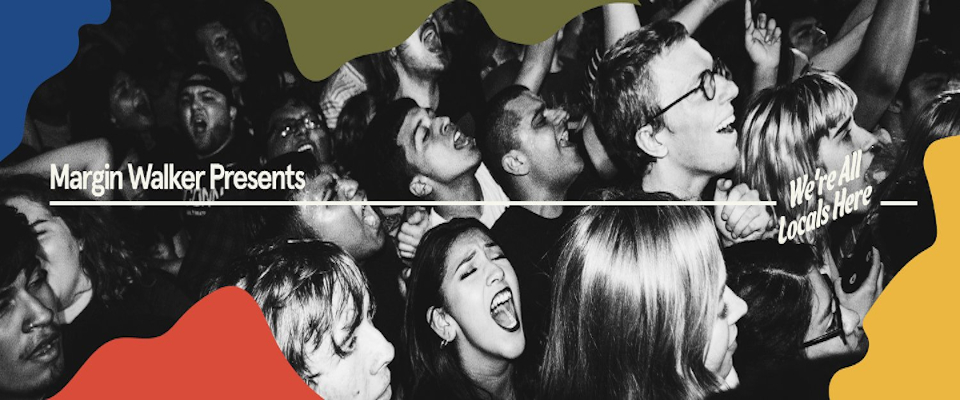Integral KUTX live music engineer steps away after a long career.
By Jeff McCord
He had a front-row seat for forty years. Since August of 1980, when new UT communications graduate Cliff Hargrove moved into full-time employment at KUT, he has engineered thousands of live music sessions, the vast majority of them mixed live on-air, without a net. In one high-pressure situation after another, even when we started doing live music on location, Cliff was the one you could always count on to keep his cool. You never heard his voice on-air, most listeners never laid eyes on him. Yet his work was as vital to the sound of KUT & KUTX as anyone on our staff.
This spring, Cliff decided it was time to retire.
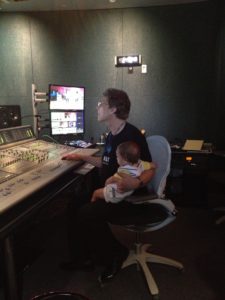
“A lot of it has to do with my family. I’ve got seven grandchildren now.” Like every other live music venue, Studio 1A has been dormant since March. His wife worked for a restaurant travel company that has folded, with her now retired, he decided to follow suit. He’s gone from babysitting rock star egos to looking after the grandkids.
Cliff grew up in Fort Worth and got the music bug early from his older brother. “He had a band, he actually played with Gary Lewis and the Playboys for a while back in the 60s.” Too young to take advantage of the city’s club scene, Cliff would go to concerts. He remembers his first. “The Shindig Tour came through Fort Worth, I was in seventh or eighth grade. I got Bobby Sherman’s autograph.”
Cliff played baritone saxophone in his school band from fourth grade all the way through his senior year, but it was his brother that offered him a real peek into the music business.
“I hung out in a recording studio when I was a teenager, a place called Sound City. My brother worked there. One of the engineers was a young 20-year-old man named T Bone Burnett. He was very tall and thin, had kind of a Beatle cut. He played guitar, and he would do session work in the studio. He was quite a bit older than me, more my brother’s age.”
“They would bring in horn sections. One of the sax players was Dean Parks, who went on to play with quite a few people on the west coast. I actually dubbed some bari sax parts. But that didn’t happen very often. Usually, they’d want me to empty the trash or, you know, get coffee or something like that.”
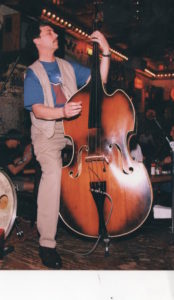
After graduating high school, Cliff headed to Austin and the University of Texas. “I started out a music major, but I wasn’t cutting it, to tell you the truth. There were some really great players there. I lasted about a year and a half, took all the theory. But I wasn’t going to be top tier, I knew that.”
By now, Cliff had switched to the bass guitar, and was playing in local bands like Zydeco Ranch, backing artists like RC Banks and Ponty Bone.
“I’m a bass player. I’m not a songwriter. I’m not a singer. You’re kind of a sideman. You’re a little limited. So that wasn’t going to be a career for me.”
At a crossroads, Cliff switched his major to communications and began studying recording techniques, working in UT’s makeshift studios, which happened to be located in the basement of CMB, sharing space with the engineering operations of KUT. It wasn’t long before Cliff was interning for the station, and when he graduated in 1980, he stepped straight into a full-time position as a KUT engineer.
“Totally inbred,” he jokes. “Back then, I think we had seven audio engineers on staff, the music production with just a small part of what KUT did. It was mostly news and information. The station was more classical than anything. I did more work in the interview studio, if I had a music session, I would leave that and go directly over the interview studio to cover interviews for KUT and NPR.”
“Studio 1A wasn’t really operational when I first got there. Actually, Walter Morgan (who followed a similar UT grad to KUT employee path about a year earlier) was the person that started putting the studio together and talked to management about the possibility of doing live music shows out of the studio. It was designed to be a classical recording studio, but it was pretty much being used as a storeroom.”

Walter created the music program Live Set, which ran on Sunday nights for 25 years, beginning in the mid-eighties. KUT hosts would book the guests and Walter would engineer. Everyone from Willie Nelson to the Shins would perform over the years. Cliff and another long-time KUT engineer, David Alvarez, would fill in for Walter when he was away. The other live music being booked on KUT at the time was primarily coming from Eklektikos host John Aielli, whose daily program ran at its peak length from 8 am to 2 pm.
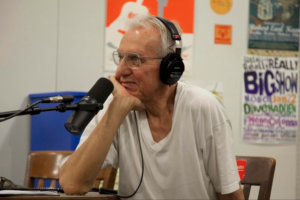
“John was the guy that brought most of the live stuff in. At first, it was mostly classical. Then we started getting into doing Zach Theater. They had a house band and they would do musicals, we did the Tommy show one time with a full orchestra. Because John was on until 2:00 in the afternoon, he would do two or three shows a day sometimes. He was really the first live music producer.”
Aside from an hour to set up, Cliff rarely knew what his days would have in store for him. “One time John brought in a Swedish girls choir, literally 40 blond girls lined up in the studio from one wall all the way around the entire studio We just put one mic in the middle of the room. I never knew until the artist or band walked in the door. Hate to say it, but it wasn’t unusual for two bands to show up a the same time because the booking process was so loose back then.”
Studio 1A wasn’t designed for loud live music. “It was tough. Not everything would work in that room. And sometimes you’d have to have arguments about how amps had to be turned toward the wall, how the drums needed to be in the far corner with baffles all around it. There was no room for an audience. All we had was the headphone system.”
“One of my early rock 1A sessions was the Fabulous Thunderbirds. Paul Ray brought them in. Jimmie Vaughan taught me some guitar and microphone techniques that I used for the rest of my career.” As other hosts, from Paul Ray to Jay Trachtenberg and Larry Monroe, began bringing in acts for their programs, the studio got busier. During early SXSW events, I would book bands in every available place, from the control room and both studios downstairs, one after another.
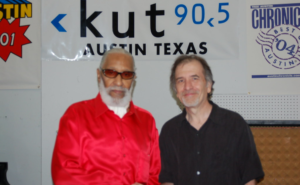
But it wasn’t until I took over as KUT’s music director in 2001 that we began purposefully booking talent on a national scale. It’s something KUTX continues to this day. I eventually turned booking over to Melanie Shrawder, current KUTX program director Matt Reilly followed her, then Peter Babb, up to our present-day live music producer Deidre Gott. All this led to a raised profile.
“We started having people like Doc Watson, Graham Nash, Rosanne Cash, Adele, Guy Clark, Ralph Stanley, Sean Lennon, Richie Havens, Ray Davies, even Kevin Bacon. I could go on,” recalls Cliff. “The star level went way up, let’s put it that way.”
When Walter Morgan took a position with Latino USA, Cliff became KUT’s primary live music engineer and would continue in that role for the rest of his career. Every day was a new challenge, the road takes its toll on touring musicians. You never know what kind of moods you’ll encounter, if they’ll be late, if their equipment will be working, if egos will flare. When you’re live on-air, deadlines are always tight. There’s always pressure. When that on-air light goes on, Cliff is always intently focused, even when there’s a big crowd behind him in the control room. You know not to bother him. But he’s never temperamental. I worked with Cliff for thirty years in all kinds of high-pressure situations – live remotes, digging through archives on deadline to find sessions for the 27 compilations of live sessions we have produced. He was never anything but professional and courteous. I can recall him losing his temper only once, to a rude entourage accompanying Los Lonely Boys. “That one almost came to blows,” he recalls.
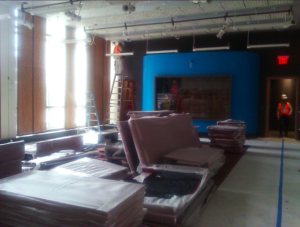
Through thousands of sessions, with all genres of music being played by every imaginable personality and circumstance, Cliff worked tirelessly to make them sound their best.
“I just love music. I have an open mind. You don’t like every band, yeah. But, you know, you have to be professional and do your job and get an idea of what they want to sound like. It’s all about working with the musician. It goes back to my days of hanging out in Sound City up in Fort Worth. They were a commercial studio so they would bring in all kinds of music. “
When asked to name his favorite session, he’s hard-pressed to come up with only one. But he has no such hesitation describing the best moment of his career – leaving the dark basement studio behind in 2013 to move into the state-of-the-art facilities of the new KUTX Studio 1A. Cliff remembers the early planning stages.
“We wanted to be able to have a live audience, that was very important to us. And we wanted a state of the art PA and mixing console and, you know, the whole nine yards really. And we got it! We actually got what we asked for. The biggest thing for me going in the new studio was – the board and the P.A. and all that was installed – but everything else was just sitting in the studio in crates. All the monitors, all the guitar amps, everything. And I got to unbox everything, hook it all up and get things up and running. When I was in college, one of the courses I took was to design a recording studio, and, you know, to be able to move in and set up. That’s like a dream come true for me.”
Few things in life perform exactly as advertised, but our new Studio 1A is a happy exception.
“We could have an acoustic solo singer-songwriter and just get a great sound. But then you bring in the loudest rock band on Earth, and because the walls are triple insulation, it just kind of absorbs the sound. So you can bring in really loud bands and still get a good sound. Unlike the old studio where it was all flat walls and no isolation, no extravagances. We’ve got the best monitors in the control room, the best monitors on stage. And over the years we’ve added just the best microphone collection you can imagine.”
All this doesn’t add up to much without the talent coming to us. Who stands out for him?
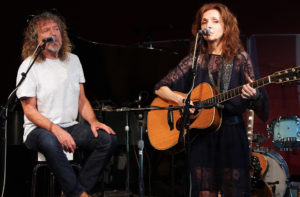
“Working with people like, say, Allen Toussaint. The classiest guy I’ve ever met in my life. He looked like a million bucks, man. Such a long career, too.”
“Of course, I would have to say Robert Plant. Led Zeppelin always stopped in Fort Worth. I would love to go to concerts then, and then actually doing a studio session with him was. Afterwards, he came into the control room, started talking with me about how Jimmy Page miked his acoustic guitars and what type of mic he traveled with when they were tour. I just couldn’t believe it. He’s was telling me about how Jimmy miked his acoustic guitar because he was asking me how I’d miked the guitars that day when he was with Patty Griffin. He just came on his own and just started shooting the breeze with me. After all those times I’ve seen him up on stage, that tall, skinny guy with that long curly blond hair.”
“And sessions with our late friend Ian McLagan. He was our personal “Rock Star”, and he was a big part of the studio after we moved in. The actual B-3 Hammond organ that Mac used on Rod Stewart’s “Maggie Mae” was played in Studio 1-A many times.”
There were a few inevitable disappointments over the years, too, sessions that just didn’t go well. The time Steve Earle began ranting in the middle of his session, likening Texas heroes of the Alamo to slave traders; a Jekyll/Hyde pair of sessions with a local musician who used to be a big part of a famous band – let’s say Derek & the Dominos. And though he’s a big fan of the new technology of several solo and duo DJ acts, Cliff finds an over-reliance on pre-recorded music a bit troubling. But he doesn’t dwell on these things. He loved the forty-year challenge of coming in every day and working on something brand new. Stepping away is difficult, but Cliff feels the time is right. “It’s been a wild ride,” he says with a twinge of regret.
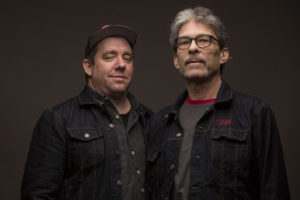
KUTX engineer Jake Perlman worked closely with Cliff over the past few years and will take over 1A whenever the time comes that we turn it back on. “Cliff couldn’t have been more gracious to me.” says Jake, “He allowed me to work alongside him, trading suggestions & ideas back and forth. It was a special working relationship. He didn’t have to be as generous, curious, and open – but I’m definitely a better engineer because he was. The “Magic Factory” (as Cliff calls Studio 1A) is a lot different without him around. I can’t wait to crank this thing back up & carry on his legacy.”
With us all of us working from home, it hasn’t really sunk in that Cliff has really retired, that we won’t be seeing him every day. After all this time of depending on him, it’s almost unimaginable. Yet as a lifetime member of our Concert Club, none of us has seen the last of Cliff. He’s too much of a music fan to stay away. When you see him, be sure to walk up, introduce yourself, and say hi and thanks to this elusive man behind the curtain. We all owe him a lot.
